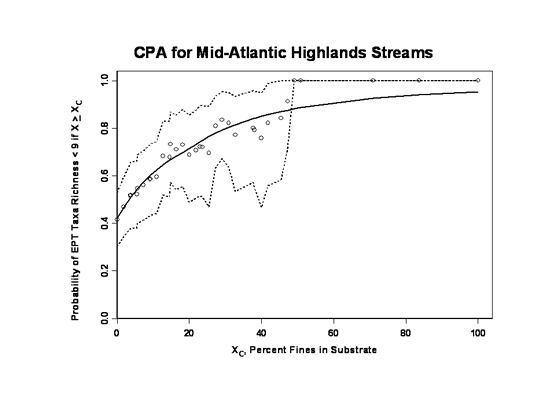Conditional Probability Analysis: EPT Taxa Richness < 9 vs. Percent Fines for Mid-Atlantic Highland Streams

Plot
- Analysis: Conditional probability analysis
- Independent variable: Percent fines in substrate ( < 0.06 mm, silt/clay)
- Dependent variable: Probability of unacceptable condition for EPT taxa richness at < 9
- Key: symbols = observations, solid line = nonlinear curve fit to the observations with a change in slope, dashed line = 95% Confidence Intervals
- Sample size: n = 99
Model
- Conditional probability analysis does not produce a model equation. Rather, it plots the probabilities of observing the stated impairment (i.e. item 3 in the list above) over a stressor intensity gradient.
- Date: 8 November 2006
Data Analysis
- Program: S-Plus Version 7.0, user written scripts, variable weighting for site data
Data Origin
- Agency: U.S. Environmental Protection Agency
- Program: Environmental Monitoring and Assessment Program (EMAP)
- Project: EMAP Surface Waters, Mid-Atlantic Streams Assessment
- Location: Mid-Atlantic region
- Environmental Monitoring and Assessment Program (EMAP) data and metadata.
Sampling Design
- Sample collected using the EMAP probability design in April through June and July through September of the years 1993 through 1996.
- Multi-habitat sample of benthos assemblage and substrate taken during spring low-flow, modified kicknet with 595 micron mesh.
- Lazorchak, J.M., Klemm, D.J., and Peck D.V. (editors). 1998. Environmental Monitoring and Assessment Program- Surface Waters: Field Operations and Methods for Measuring the Ecological Condition of Wadeable Streams. EPA/620/R-94/004F.
- U.S. Environmental Protection Agency, Washington, D.C. Catalog Documentation for EMAP Surface Waters 1993-96 Mid-Atlantic Streams Data.
Contact
John F. Paul, paul.john@epa.gov, (919) 541-3160
